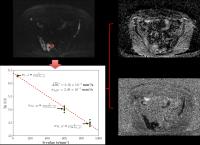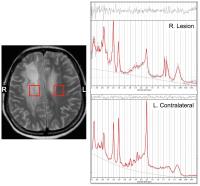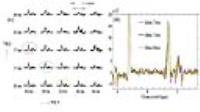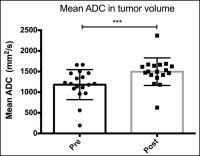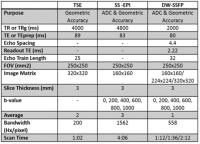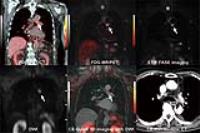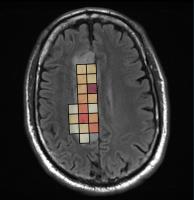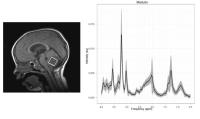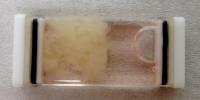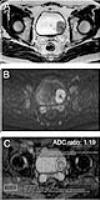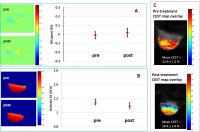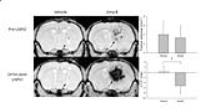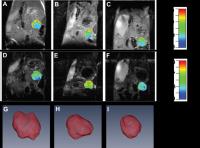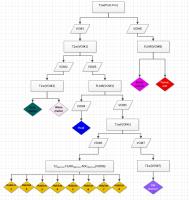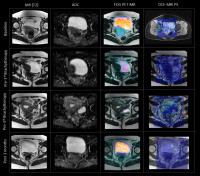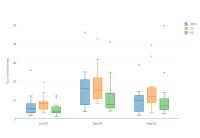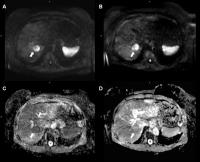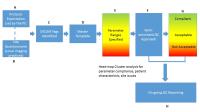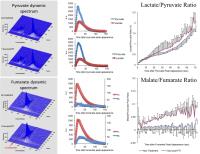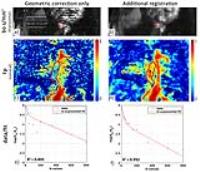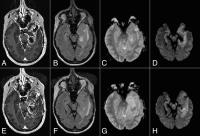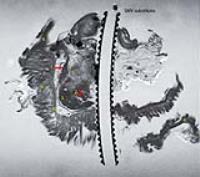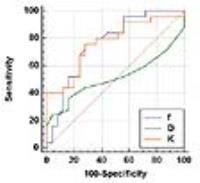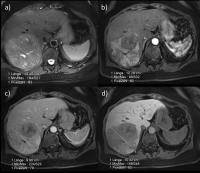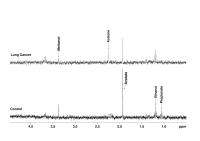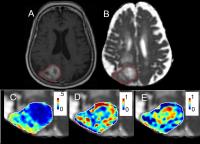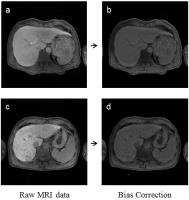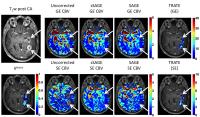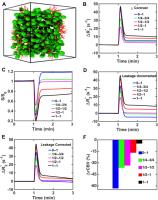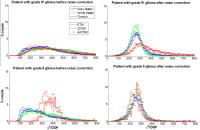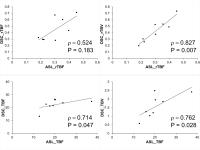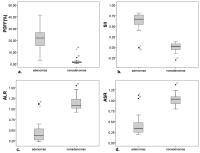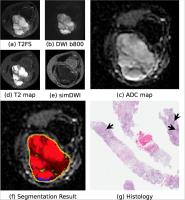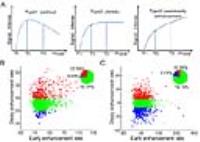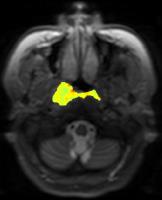|
2471.
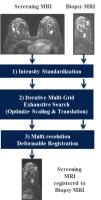 |
Co-registration of pre-biopsy and biopsy MRIs to facilitate
lesion localization for MR-guided breast biopsies
Mirabela Rusu1, Elizabeth A. Morris2,
Elizabeth J. Sutton2, and Ileana Hancu1
1GE Global Research, Schenectady, NY, United
States, 2Memorial
Sloan Kettering Cancer Center, New York, NY, United States
Lesion identification in MR-guided biopsy exams can be
hampered by many factors, including large deformations and
limited tissue perfusion due to breast compression. Multiple
post-contrast scans, image subtraction and maximum intensity
projection map generation may be needed to relocate the
lesion. This preliminary study suggests that non-rigid
registration between the (uncompressed breast) pre-biopsy
series and the (compressed breast) biopsy series may
facilitate fast and accurate lesion (re)localization, even
with limited/absent lesion enhancement.
|
|
2472.
 |
The test-retest reliability of fat-water ratio MRI derived
breast density measurements and automated breast segmentation 
Jie Ding1, Patricia A Thompson2,
Marilyn T Marron3, Maria Altbach3,4,
Denise Roe3,5, Jean-Philippe Galons4,
Cynthia A Thomson3, Fang Wang6, Alison
Stopeck7, and Chuan Huang1,8,9
1Biomedical Engineering, Stony Brook University,
Stony Brook, NY, United States, 2Pathology,
Stony Brook Medicine, Stony Brook, NY, United States, 3Cancer
Center, University of Arizona, Tucson, AZ, United States,4Medical
Imaging, University of Arizona, Tucson, AZ, United States, 5Epidemiology
and Biostatistics, University of Arizona, Tucson, AZ, United
States, 6Stony
Brook Medicine, Stony Brook, NY, United States,7Hematology
and Oncology, Stony Brook Medicine, Stony Brook, NY, United
States, 8Radiology,
Stony Brook Medicine, Stony Brook, NY, United States, 9Psychiatry,
Stony Brook Medicine, Stony Brook, NY, United States
It has been shown that breast density (BD) value derived
from fat-water-ratio MRI (FWR-MRI) strongly correlates with
standard digital mammogram derived BD. The fact that no
ionizing radiation is associated with FWR-MRI makes it a
lower-risk modality for long term BD monitoring and clinical
trials. However, data regarding the individual and group
level variability and reliability of this method needs to be
established. Conventional approaches for FWR-MRI derived
BD rely on manually drawn regions-of-interest. These
processes are cumbersome and prone to measurement bias,
which may limit the application of FWR-MRI derived BD.
Automated breast segmentation has been proposed to resolve
this problem and limited results to date are promising.
Additional data including an evaluation of BD reliability
from manual versus automated measurements is still needed.
In this study, we evaluate the test-retest reliability of
the FWR-MRI derived BD and the quality of data using manual
versus automated breast segmentation. Our results
demonstrate the high reliability of the FWR-MRI derived BD
measure, Fra80, with a typical error of less than 0.02 for
both automated and manual breast segmentation. Moreover, our
automated breast segmentation protocol yields more reliable
Fra80 BD measures compared to the labor-intense manual
segmentation method.
|
|
2473.
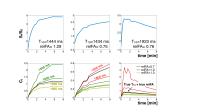 |
Dependence of Breast Pharmacokinetic Parameters on pre-contrast
T1 and flip angle 
Subashini Srinivasan1, Bruce L Daniel1,
and Brian A Hargreaves1
1Radiology, Stanford University, Stanford, CA,
United States
Pharmacokinetic (PK) models have been used to estimate
physiological parameters such as permeability and dispersion
of the contrast agent and is estimated using the acquired
signal, pre-contrast T10, and the acquisition flip angle. In
this work, we have determined the dependence of the
dispersion models’ and Tofts models’ PK parameters on T10
and B1 maps, as well as the errors introduced by using
constant T10 and B1 values in 11 biopsy-proven tumors. Our
results show that PK parameters such as kep of Tofts model
and kappa of mLDRW dispersion model are less dependent on
T10 and B1 and could potentially be used with higher
accuracy and precision even when T10 and B1 maps are not
acquired.
|
|
2474.
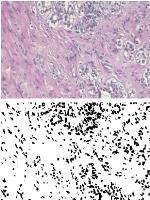 |
Estimation of breast tumour tissue diffusion parameters from
histological images and Monte-Carlo simulations 
David Naves Sousa1, Filipa Borlinhas1,
and Hugo Alexandre Ferreira1
1Institute of Biophysics and Biomedical
Engineering, Faculdade de Ciências da Universidade de
Lisboa, Lisboa, Portugal
Diffusion-Weighted Imaging is a MRI technique that is able
to distinguish between benign and malignant breast tumours
via the Apparent Diffusion Coefficient (ADC). Nevertheless,
this parameter provides very limited information regarding
tissue microstructure. Here, is presented an approach to
estimate the intracellular (Di) and extracellular (De)
diffusion coefficients, and cell membrane permeability of
tumour tissues which makes use of known ADC values,
histological images and Monte-Carlo simulations of diffusion
processes. Results show that distinct combinations of (Di,
De, P) correlate with tumour type, and that a decreased De
was observed in malignant tumours in agreement with known
extracellular matrix changes.
|
|
2475.
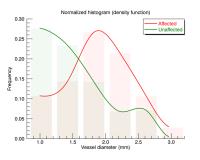 |
Magnetic resonance lymphangiography in breast cancer related
lymphoedema shows differences between affected and unaffected
arms
Marco Borri1, Maria A. Schmidt1, Julie
C. Hughes1, Erica D. Scurr1, Kristiana
D. Gordon2,3, Peter S. Mortimer2,3,
Dow-Mu Koh1, and Martin O. Leach1
1CR-UK Cancer Imaging Centre, The Royal Marsden
NHS Foundation Trust and The Institute of Cancer Research,
London, United Kingdom, 2Cardiac
and Vascular Sciences, St. George’s, University of London,
London, United Kingdom, 3Skin
Unit, The Royal Marsden NHS Foundation Trust, London, United
Kingdom
The pathophysiology of breast cancer related lymphoedema
(BCRL) is not well understood, one of the main limiting
factors being a lack of information on lymphatic collecting
vessels. We have recently proposed a novel contrast-enhanced
magnetic resonance lymphangiography protocol which allows
the identification of lymphatics via the use of associated
contrast uptake curves. In this work we have quantified
differences between affected and unaffected arms in a cohort
of patients with unilateral BCRL. Our analysis did not
detect significant differences in vessel counts between the
two sides within different sections of the forearm. However,
there was a statistically significant difference in vessel
diameter between the two arms; lymphatics within the
affected arms presented with a larger diameter.
|
|
2476.
 |
Reproducibility of quantitative magnetization transfer imaging
of the healthy breast at 3T 
Lori R. Arlinghaus1, Richard D. Dortch1,2,
Jennifer G. Whisenant2, Hakmook Kang3,
and Thomas E. Yankeelov1,2
1Institute of Imaging Science, Vanderbilt
University, Nashville, TN, United States, 2Department
of Radiology and Radiological Sciences, Vanderbilt
University, Nashville, TN, United States, 3Department
of Biostatistics, Vanderbilt University, Nashville, TN,
United States
Magnetization transfer (MT) imaging is sensitive to changes
in the macromolecular content of tissue and is, therefore,
gaining increased attention as a noninvasive approach to
probe the complex tumor environment in cancer. The ratio of
macromolecular protons to the protons in the free water
pool, or pool size ratio (PSR), can be quantified with
quantitative MT (qMT) imaging and may be useful for
detection of changes in macromolecular content early in the
course of treatment. In this study, we explore the
repeatability of PSR measurements in healthy breast
fibroglandular tissue at 3T to serve as a benchmark for
future longitudinal studies of breast cancer treatment.
|
|
2477.
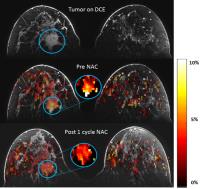 |
Amide CEST at 7T: A possible biomarker for response to
neoadjuvant chemotherapy in breast cancer 
Erwin Krikken1, Moritz Zaiss2, Vitaliy
Khlebnikov1, Hanneke W.M. van Laarhoven3,
Dennis W.J. Klomp1, and Jannie P. Wijnen1
1Radiology, University Medical Center Utrecht,
Utrecht, Netherlands, 2Deutsches
Krebforschungszentrum, Heidelberg, Germany, 3Medical
Oncology, Academic Medical Center Amsterdam, Amsterdam,
Netherlands
Neoadjuvant chemotherapy has an important role in the
treatment of breast cancer and the need for early detection
of treatment response is high. As a non-invasive method able
to predict treatment response is lacking, we investigated
the feasibility of using amide CEST MRI at 7T as a
biomarker. Six patients were included after informed consent
was given. The ATP signal was robust and repeatedly
detectable in the same patient. Significant differences were
seen in amide signal before and after the first cycle of
chemotherapy.
|
|
2478.
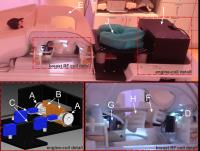 |
A compact and easy to handle set-up for high quality MR
Elastography of the breast. 
Jurgen H Runge1, Jules L Nelissen2,3,
Larry de Graaf2, Barbara Molenkamp4,
Suzan van der Meij4, Klaas Nicolay2,
Gustav J Strijkers3, Jaap Stoker1,
Anneloes E Bohte1, Aart J Nederveen1,
Ondrej Holub5, and Ralph Sinkus5
1Radiology, Academic Medical Center, Amsterdam,
Netherlands, 2Biomedical
NMR, Eindhoven University of Technology, Eindhoven,
Netherlands, 3Preclinical
and Translational MRI, Academic Medical Center, Amsterdam,
Netherlands, 4Surgery,
Academic Medical Center, Amsterdam, Netherlands, 5Biomedical
Engineering, King's College London, London, United Kingdom
Distinction between benign and malignant breast lesions
remains difficult with conventional (dynamic)
contrast-enhanced MRI. MR Elastography (MRE) can distinguish
benign and malignant tissues based on their viscoelastic
properties but breast MRE has not found widespread use in
daily clinical practice, because of the complex equipment
required and cumbersome data acquisition. Here we present a
compact, easy to handle breast MRE set-up that allows the
acquisition of high quality, artefact-free MRE data. This
set-up was designed, built and tested at two different
institutions in volunteers and a patient.
|
|
2479.
 |
Dual-Parametric MR Imaging with Read-Out Segmented
Diffusion-Weighted and High Temporal Resolution Dynamic
Contrast-Enhanced Imaging Improves the Differentiation of
Malignant and Benign Breast Lesions
Bin Wu1,2, Yanqiong Chen2, Hui Liu3,
Xu Yan3, Caixia Fu4, Dan Wang1,
Jian Mao2, Dominik Nickel5, Berthold
Kiefer5, Yajia Gu2, and Weijun Peng2
1Radiology, Shanghai Proton and Heavy Iron
Center, Fudan University Caner Center, Shanghai, China,
People's Republic of, 2Radiology,
Fudan University Shanghai Cancer Center, Shanghai, China,
People's Republic of,3NEA MR Collaboration,
Siemens Ltd, Shanghai, China, People's Republic of, 4Siemens
Shenzhen Magnetic Resonance Ltd, Shenzhen, China, People's
Republic of, 5Siemens
Healthcare GmbH, Erlangen, Germany, Forchheim, Germany
We investigated the clinical value of a dual-parameter
classification method in differentiating benign and
malignant breast lesions using readout-segmented
diffusion-weighted imaging (RS-DWI) and quantitative dynamic
contrast-enhanced magnetic resonance imaging (DCE-MRI), and
found they correlated with histological results.
|
|
2480.
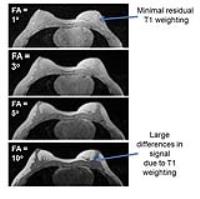 |
Proton Density Water Fraction as a Measurement of Breast
Fibroglandular Tissue Volume and Concentration
Roberta M Strigel1,2,3, Leah Henze Bancroft2,
Diego Hernando1, and Scott B Reeder1,2,3,4,5,6
1Radiology, University of Wisconsin, Madison, WI,
United States, 2Medical
Physics, University of Wisconsin, Madison, WI, United
States, 3Carbone
Cancer Center, University of Wisconsin, Madison, WI, United
States,4Biomedical Engineering, University of
Wisconsin, Madison, WI, United States, 5Emergency
Medicine, University of Wisconsin, Madison, WI, United
States, 6Medicine,
University of Wisconsin, Madison, WI, United States
Elevated breast density confers an increased risk for breast
cancer. Accurate and precise measurement of the amount of
fibroglandular breast tissue has potential to serve as a
quantitative imaging biomarker of risk for the development
of breast cancer. In this work we introduce novel,
confounder corrected chemical-shift encoded (CSE)-MRI
techniques to measure the proton density water fraction
(PDWF). Estimation of PDWF with CSE-MRI addresses potential
confounders that negatively impact accuracy, precision, and
reproducibility, enabling protocol independent
quantification of the volume and concentration of
fibroglandular tissue in the breast.
|
|
2481.
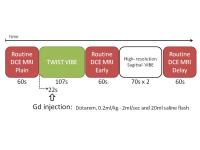 |
Utility of semi-quantitative analysis of initial enhancement
using TWIST-VIBE in the diagnosis of breast lesions
Mariko Goto1, Koji Sakai1, Kayu
Takezawa1, Hiroshi Imai2, Elisabeth
Weiland3, and Kei Yamada1
1Radiology, Kyoto Prefectural University of
Medicine, Kyoto, Japan, 2Siemens
Japan K.K., Tokyo, Japan, 3Siemens
Healthcare GmbH, Erlangen, Germany
The prototype TWIST-VIBE sequence improves the temporal
resolution of breast MRI while preserving spatial
resolution. High-temporal resolution TWIST-VIBE was
performed during the initial enhancement phase and
high-spatial resolution routine DCE MRI in a single session,
and whether the additional information of initial
enhancement analysis using TWIST-VIBE improved the
diagnostic accuracy of breast MRI was evaluated. The
combination of BI-RADS and new parameters of initial
enhancement (MS and TTE) calculated from TWIST-VIBE has the
potential to increase the specificity of breast MRI and may
be useful as additional information to determine the need
for biopsy.
|
|
2482.
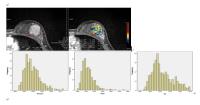 |
Application of Histogram Analysis of Pharmacokinetic Parameters
in Dynamic Contrast-Enhanced MR Imaging of Breast lesions with
CAIPIRINHA-Dixon-TWIST-VIBE Technique
Yiqi Hu1, Tao Ai1, and Liming Xia1
1Tongji Hospital, department of radiology, Wuhan,
China, People's Republic of
The overlap of pharmacokinetic parameters values exists
between benign and malignant lesions. Most previous studies
chose mean pharmacokinetic parameters when elevating the
state of breast lesions perfusion. However, tumors are
heterogeneous that are marked by microenvironmental factors
and thus manifests as radiologic heterogeneity. The mean
pharmacokinetic parameter values may overlook the subtle but
important difference between breast lesions. Thus, the aim
of our study is to investigate the feasibility of histogram
analysis of pharmacokinetic parameters including Ktrans,
kep, ve in breast DCE-MRI imaging and determine which metric
of each pharmacokinetic parameter may best help
differentiate benign from malignant lesions.
|
|
2483.
 |
Influence of fat suppression to evaluate T1 values in breast
cancer: assessing the reliability of pharmacokinetic parameters
Kayu Takezawa1, Mariko Goto1, Koji
Sakai1, Hiroyasu Ikeno1, Katsuhiko
Nakatsukasa2, Hiroshi Imai3, and Kei
Yamada1
1Radiology, Kyoto Prefectural University of
Medicine, Kyoto, Japan, 2Breast
Surgery, Kyoto Prefectural University of Medicine, Kyoto,
Japan, 3Siemens
Japan K.K, Tokyo, Japan
The influence of fat suppression on T1 values and
pharmacokinetic parameters in breast cancer were evaluated
using a prototype Dixon-TWIST-VIBE technique. We measured T1
values of breast cancers on both fat suppression and not-fat
suppression data sets and we calculated Ktrans values
using same ROI that employed on T1 value measurements. Our
result suggests that the fat suppression might influence T1
values in breast cancer, and reliability of Ktrans seemed
inappropriate as an absolute value. On the other hand, the
assessment of intra-patient Ktrans change
might be feasible.
|
|
2485.
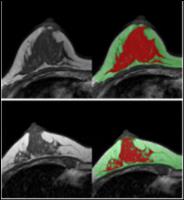 |
3D MRI Breast Density Change in Women with Hormonal Positive
Breast Cancer Following Adjuvant Hormonal Therapy
Yoon Jung Choi1, Jeon-Hor Chen2,3,
Shunshan Li2, Po-Han Chen4, Pei-Yu Liu4,
Inyoung Youn1, and Min-Ying Su2
1Department of Radiology, Kangbuk Samsung
Hospital, Seoul, Korea, Republic of, 2Center
for Functional Onco-Imaging, Department of Radiological
Sciences, University of California Irvine, Irvine, CA,
United States,3Department of Radiology, Eda
Hospital and I-Shou University, Kaohsiung, Taiwan, 4Department
of Medical Imaging, China Medical University, Taichung,
Taiwan
Hormonal regimens may affect breast tissue with the change
of breast volume or composition. This study was to apply a
well-established breast and fibroglandular tissue
segmentation method to analyze the density changes in
patients receiving adjuvant hormonal therapy. The results
showed that pre-menopausal women had a higher density
reduction, presumably due to their more abundant
fibroglandular tissues that can be decreased, but a high
variation was observed. The density reduction assessed by 3D
MRI may be used as a surrogate marker to correlate with
metabolic genotyping, and further used in combination to
better predict patient’s prognosis.
|
|
2484.
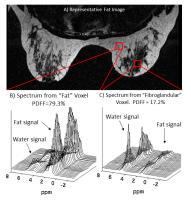 |
Rapid T1 and T2 Measurements of Breast Tissue at 3T using
Multi-TR, Multi-TE Spectroscopy 
Leah C Henze Bancroft1, Roberta M Strigel1,2,3,
Gavin Hamilton4, Scott B Reeder1,2,5,6,7,
and Diego Hernando2
1Medical Physics, University of
Wisconsin-Madison, Madison, WI, United States, 2Radiology,
University of Wisconsin-Madison, Madison, WI, United States, 3University
of Wisconsin Carbone Cancer Center, University of
Wisconsin-Madison, Madison, WI, United States, 4Radiology,
University of California, San Diego, San Diego, CA, United
States, 5Medicine,
University of Wisconsin-Madison, Madison, WI, United States, 6Biomedical
Engineering, University of Wisconsin-Madison, Madison, WI,
United States, 7Emergency
Medicine, University of Wisconsin-Madison, Madison, WI,
United States
The highly heterogeneous distribution of fat and
fibroglandular tissue in the breast makes obtaining accurate
measures of T1 and T2 relaxation times difficult. Here, a
rapid, multi echo, multi TR spectroscopy sequence is used to
measure the T1 and T2 relaxation times of fat and
fibroglandular tissue in the breast at 3T. Partial voluming
effects are accounted for through accurate measurement of
the proton density fat fraction.
|
|
2486.
|
Does the Initial Enhancement Ratio (IER) Predict which
Malignancies are Biologically Significant on a Pre-operative
Breast MRI?
Neeti R Bagadiya1, Laura Heacock1,
Yiming Gao1, Meghan Jardon1, Samantha
Heller1, and Linda Moy1
1Radiology, New York University, New York, NY,
United States
Breast MRI allows preoperative identification of patients
who may have extensive disease at presentation and allows
for appropriate surgical planning and treatment. Despite
the high sensitivity of MRI, the role of preoperative
surgical staging of breast cancer patients is controversial.
There is concern that the high false positive rates of
breast MRI lead to additional biopsy procedures and
surgeries [1,2]. Abbreviated breast MRI (AB-MR), defined as
the first post-contrast scan, has been proposed as an exam
that may have a higher specificity compared to conventional
breast MRI [3,4]. Two recent studies show that AB-MR has a
high PPV for and may preferentially selects for biologically
significant tumors, thereby reducing overdiagnosis and
overtreatment. The concept of a biologically significant
breast cancer has not been defined. We hypothesized that
since invasive carcinomas usually demonstrate fast initial
uptake of contrast, a threshold of enhancement as determined
by initial enhancement ratio (IER) may be associated with
the identification of biologically significant breast
cancers [5]. We evaluated a cohort of women with known
cancer who underwent MRI guided needle localization (MRNL)
for a finding that was suspicious for additional disease.
We examined whether there was an association with the IER
and the likelihood that it would be detected on AB-MR exam.
Using Dynacad software we retrospectively reviewed the IER
of MRI detected synchronous cancers that underwent MRNL. We
found there is a significant correlation between invasive
cancers and IER that can aid in the detection of
biologically significant synchronous cancers on MRI.
|
|
